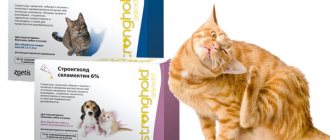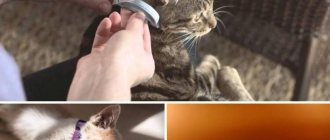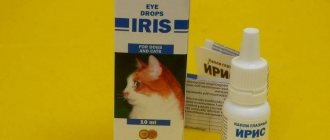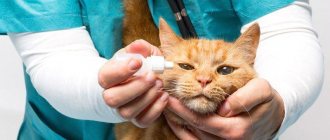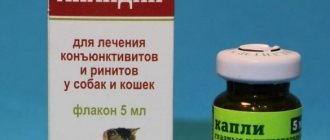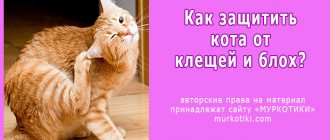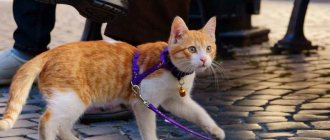Fleas are blood-sucking insects that feed on the blood of warm-blooded mammals. Common species: cat fleas (Ctenocephalides felis), human fleas (Pulex irritans), dog fleas (Ctenocephalides canis), rat fleas (Xenopsylla cheopis). These groups of parasites do not specialize in one host - the dog flea bites cats, the cat flea bites dogs, and the rat flea attacks people. Fleas are insects that undergo metamorphosis (complete transformation), including four stages of development - egg (7-14 days), larva (10-15 days), pupa (6-10 days), imago (3-18 months). Adult fleas jumping around the house and biting a dog or cat make up only 5-7% of the parasite population in the apartment, 35% are larvae, 10% are pupae, 50% are eggs. In addition, a flea does not live permanently on a pet’s body, so treatment against insects must be comprehensive: the use of drugs based on growth regulators to treat the animal + sanitary treatment of the premises.
There are many means to get rid of and prevent the appearance of parasites, the most effective of which are flea drops. They are used for the treatment and protection of sexually mature animals, kittens and puppies up to 3 months.
Types and composition of drops
Flea drops are a concentrated solution of insecticides, which are characterized by low toxicity and rapid action. The best option is drugs with juvenile effects that block the development mechanism of blood-sucking individuals at all stages:
- phenylpyrazoles (pyriprole, fipronil). The safest substances, since they preferentially inhibit GABA receptors of insects and not animals, which guarantees reliability for antiparasitic use. They work in a contact way, causing flea hyperactivity and their subsequent death;
- organophosphorus compounds (organophosphates, FOS). They are highly toxic, irritate the skin, irreversibly suppress (inhibit) enzymatic and physiological processes, accumulate in the animal’s body; with prolonged use, fleas develop resistance (resistance) to the drug and it stops working;
- pyrethroids. Safe for dogs/cats due to the absence of mutagenic and carcinogenic properties. Often cause skin reactions, do not penetrate into the blood;
- ivermectin. Affects the nervous system of fleas, prevents the maturation of eggs, pupae, larvae, and is moderately toxic. It is not recommended to treat sick, weakened animals or lactating bitches with preparations containing ivermectin;
- diflubenzuron. It inhibits the production of quinine, which protects the integument of eggs/larvae, has a weak effect on adults, and has low toxicity.
In addition to the basic insecticide, flea drops contain hormones that regulate stage-by-stage development (juvenile), synergists (enhancers) of the action of insectoacaricides, and additional substances that affect specific types of insects.
Action
The use of drugs is allowed for kittens starting from 2 months. The components of liquid preparations against ectoparasites penetrate through the pet’s skin into the fat layer or into the blood, making the cat’s blood toxic to insects. All insecticides have an unpleasant odor, which fleas and other pests rush to get rid of and quickly leave the owner - the cat.
- The drug quickly rids the cat of adult specimens;
- The deposited larvae in the pet’s fur die;
- Under the influence of the product, hatched fleas quickly jump off the cat;
- The use of the drug eliminates the possibility of re-infection through contact with other carriers of parasites;
- All ectoparasites are avoided from pet skin treated with such products;
- When a tick gets on the treated skin of a cat, it cannot penetrate and falls off.
All insecticidal agents against ectoparasites are harmless to animals and humans, but are destructive to pests.
How do flea drops work?
After application, the drops migrate through the fatty layer of the animal’s skin, the active substance is distributed, without penetrating into the bloodstream, through this layer, quickly absorbed into the hair follicles and sebaceous glands, returning over time back to the upper layers of the epidermis.
Pros:
- treating an animal with drops is more reliable and simpler than treating with an emulsion/spray; an additional bonus is savings when treating large breed dogs;
- from the point of view of ease of treatment, drops are the most reliable means of protection;
- there is no problem with determining the dosage;
- the risk of the substance getting on the mucous membranes and licking is minimal;
- long-term effect on insects - the drug actively works for 1-2 months.
Minuses:
- the drops do not begin to act immediately, it takes 12-14 hours for them to “unfold”;
- the effectiveness of the substance may be reduced due to unpredictable factors - swimming, rain, sunlight, dirt;
- the drug may not “reach” the tail, ears, or paws of the animal;
- There are real risks of overdose, especially for cats/dogs whose weight does not exceed 2 kilograms.
Drops should be counted on as a priority treatment and protection for your pet. The safest insecticides are phenylpyrazoles and pyrethroids; more toxic substances in drops can be potentially dangerous.
Requirements for the product for skin application of spot-on against fleas
To choose the right drug for a kitten or adult animal, you need to consult a doctor. Spot-on facilities must meet the following requirements.
Efficiency.
The drops are really effective against most skin parasites. They help to quickly get rid of fleas without harming the animal.
Safety.
The “toxic” substances in the drugs only affect pests. They are practically safe for cats' health. But, like any medicine, spot-on drops have contraindications, so before using the product you should consult a specialist.
Versatility.
Spot-on products are suitable not only for the complete destruction of insects. The drug will prevent infection if you go with your pet to nature, becoming an excellent preventive measure. In addition, many products have a complex effect, also protecting against ticks, lice, lice, and some against intestinal parasites.
How to choose effective drops
Choosing an anti-flea agent is a serious matter, since not all drops are equally safe and effective. Before purchasing them, you should consult with your veterinarian so that he can help you calculate the dosage depending on the weight/age of your pet.
Instructions:
- Study the range of drops in a veterinary pharmacy, paying attention to the concentration and degree of toxicity of insecticides and additional substances. The effectiveness of the drug is determined on the basis of special tests, the result of which is the “flea control” index; it should be at least 80-90%; if the figure is lower, it is better not to buy drops.
- Make sure that the expiration date has not expired.
- Consider the age of the cat or dog: drops for puppies and kittens, weakened animals, lactating/pregnant bitches have a lower content of active ingredients.
- You should not treat cats with drops for dogs and vice versa - this can lead to intoxication of the animal.
- It is not recommended to use two or more types of drops at the same time - this is fraught with a weak antagonist, suppression of transport and synergy, and an abnormal increase in toxicity. Conditionally safe options: phenylpyrazoles + pyrethroids; if necessary, carbamates can be added to the mixture.
How to use the drug correctly
How Bars drops work and whether they can fully protect an animal from parasites largely depends on whether they are applied correctly.
It is important to follow the recommendations.
Place of application
. The drug should be dripped onto the neck: from the base of the skull to the area between the shoulder blades. Bars drops should be applied at several points; you cannot use the entire required dose for use on one area of the skin. It is important that the areas where the drug is located are inaccessible to the pet for licking. Do not apply drops to damaged skin.
Bars drops are used, among other things, to treat otodectosis. In this case, the drug is instilled into the external auditory canal, after which the ears are massaged to evenly distribute the product over the surface of the skin. When otodectosis occurs, both ears need to be treated, even if signs of the disease are present on only one side.
Application method
. The drug needs to be dripped onto the skin, and not onto the fur - this is important. You should separate the hair on selected areas of the animal’s body and apply drops to the exposed skin. For long-haired dogs, you can part it and squeeze the product onto the exposed skin. There is no need to rub the drug or carry out other manipulations.
When treating otodectosis, after instilling drops, the edges of the ears are connected and massaged at the base.
The period before and after.
Three days before applying the drops to the withers and three days after, you should not bathe your dog or cat. The fact is that soap or shampoo washes away the fatty lubricant of the hair. This will disrupt the process of spreading the drug over the skin and greatly reduce the effectiveness of the product. Therefore, during the “waiting” period, it is better to choose clean places to walk the dog or limit its activity to avoid the need for bathing. Also, do not apply the drug to wet skin or walk your dog in the rain immediately after application.
Handling multiple animals
. It is not advisable to apply Barca against fleas to several animals from one pipette. You will not be able to control the accuracy of product consumption. It is better to buy two ampoules-pipettes of the recommended volume than one large one for two. After application, animals must be isolated from each other for a day. This is especially important if your dogs or cats are friendly and may lick each other. After the drug has been absorbed into the skin, you can safely “reunite” your pets. Also, these restrictions must be observed for close contacts with the pet - do not pet them for 24 hours and do not allow children to do this.
Regularity of processing
. It is recommended to apply Bars drops no more than once every 4 weeks. During this time, the pet is reliably protected from external parasites and ixodid ticks.
Dosage
. Drops must be applied exactly according to the instructions. One pipette with the smallest dose contains 1.4 ml of the drug, this is enough to treat an animal weighing from 2 to 10 kg.
For dogs weighing 10–20 kg, the dose should be doubled. For pets weighing 20–30 kg, you need to use 4.8 ml of drops, and over 30 kg – from 5 to 10 ml, depending on how much the dog’s weight exceeds 30 kg.
But in all cases, if you have questions or doubts, it is best to seek advice from a veterinarian. The specialist will select the correct dosage in exact accordance with the animal’s body weight and give additional recommendations if there is an objective need for them.
Review of popular flea drops
- Advantix. A drug based on permethrin. It has a high dosage of pyrethroids (compared to the norm, it is exceeded by the manufacturer by 5-10 times), which can cause irritation of the skin of animals and an allergic reaction in cats. Protection in 50% of cases of use. It is recommended to use simultaneously with the Kiltix collar, propoxur or fipronil sprays.
- UltraGuard. The most reliable drops with pyrethroids, safe, do not cause irritation or allergies, optimally used with an UltraGuard collar.
- Leopard. A popular domestic product, it is available in two versions - based on permethrin and fipronil. Only 20% of penetration was detected. A good inexpensive drug, but there are two points: It is recommended to purchase Leopard only from trusted suppliers in order to avoid counterfeiting; the manufacturer sometimes makes mistakes in doses in batches, so it is better to reduce processing time; for large animals, increase the dose by one pipette. Works reliably in combination with Bars spray and Kiltix collar.
- Frontline. They “break through” in 40% of cases, combined with Bars/Bolfo sprays.
- Inspector. Intended for the treatment and prevention of flea infestation, used for damage by fleas, ticks, lice eaters. Contraindicated for puppies and kittens under 7 weeks of age.
Advantages over other insecticidal drugs
suppress the onset of fleas , ticks , and intestinal parasites in a variety of ways. But if you want to get rid of unwanted guests as soon as possible and for a long time, insecticidal drops will be the best remedy .
The popularity of such tools can be explained simply:
- All types of drops are produced in special dropper pipettes . Thus, calculating the dosage of the drug is significantly simplified;
- You can treat a cat captivated by fleas even without outside help;
- most drop manufacturers exclude the possibility of re-infection with parasites within several months after using the product.
Rules of application
Before applying the medicine, you must carefully examine the cat/dog's skin for rashes and wounds:
- drops are applied to the withers at one point, for greater effectiveness - along the ridge at several points, avoiding contact with the fur if possible. A small amount of the drug is applied under the neck, at the base of the skull, distributed over the back;
- The cat or dog should not be bathed 24 hours before and after treatment, so as not to damage the fatty layer of the skin. Compliance with this rule is mandatory; if ignored, treatment will have to be repeated;
- droplet protection weakens over time: the highest protection profile is observed in the first 7 days, after three weeks the containment indicator decreases by 10 points, after 4 - by 25-30 points.
How to quickly remove a bruise on your face
A black eye appears much faster than in other parts of the body. If measures are not taken quickly, the resorption of the bruise will take a long time. The reason is the location of the vessels and the loose subcutaneous tissue that surrounds the eyes. It easily becomes saturated with blood and swells.
First aid after injury is to apply ice to the face. Of the folk methods of struggle, it is necessary to use safe ones that will not irritate the mucous membrane of the eyes. Therefore, a paste of onion, vinegar or garlic will not work. But you can use:
- raw potatoes;
- parsley paste;
- a piece of raw pineapple (not canned);
- essential oils.
They are also treated with pharmaceuticals containing heparin, diclofenac and ibuprofen. Bruises on the face can be smeared with gel with troxevasin. It reduces swelling, pain, relieves inflammation, increases capillary tone and reduces their fragility. Troxevasin helps to quickly remove bruises and strengthen small blood vessels. It is recommended to use it 2-3 times a day.
If the bruise is large and does not want to dissolve, you can try to hide it with the help of cosmetics. Women apply a special color corrector to the defect on the face, which covers the blue tint, after which the skin is smoothed with foundation and powdered.
Why do drops work poorly or don’t help?
If after treating the animal it was not possible to get rid of fleas, there may be two reasons:
- non-compliance with dosage. The dosage must be observed as strictly as possible: exceeding it is fraught with poisoning, and an insufficient amount of the drug will not give the expected effect;
- violation of technology. You should not treat the animal's paws, or the animal's belly - only the withers, otherwise the animal will lick the substance, which can lead to intoxication and a sharp decrease in effectiveness.
Sometimes even expensive, proven drops do not work - this is explained by the fact that fleas develop resistance to a certain insecticide, in which case the drug should be replaced with another, which contains an insecticide of a different class.
For the little ones
It is worth removing fleas from kittens using drops only if they have been weaned from the cat and when the number of parasites threatens the health of the babies. It is important to remember that the insecticides included in the preparations can cause serious harm to a fragile child’s body .
Drops can only be used when the animal reaches two months of age . If the kitten has not yet crossed this age limit, it is better not to risk it and postpone the treatment process, or try to remove some of the parasites with a comb.
Today, there are several types of drops that can be used to treat small pets. These are the drugs:
- Celandine Junior (used from 8 weeks of age).
- Advantage (applicable at 10 weeks of age).
- " Frontline " (used from 8 weeks of age).
- Stronghold (used from 8 weeks of age).
We also recommend reading the article about the types of flea treatments for kittens.
Cat fleas are a real scourge both for the animal itself and for its owners. In addition to the above mentioned remedies, these parasites can be removed using tar soap and Advocate drops.
id=»u»>Can drops be used to treat a room?
No you can not. To treat the premises, special preparations containing a higher concentration of chemicals should be used. Due to their toxicity, during spraying it is necessary to use personal protective equipment (mask, gloves, goggles), and take household members and pets outside. If parasites have spread throughout the house, the algorithm of action should be as follows: treatment of the pet until complete recovery - sanitization of the premises - repeated sanitization.
Methods of flea infestation
Most often, an animal becomes infected on the street, but even a domestic cat that has never left the apartment and has not been in contact with sick animals can become a victim of blood-sucking insects.
The main factor is the presence of eggs laid by fleas, which the owner himself can bring into the house, for example, on the sole of a shoe.
Close-up view of a flea.
Overdose
Poisoning of dogs and cats with flea drops is extremely rare (3-5% of cases); the risk group includes sick, elderly, weakened animals, puppies and kittens.
Symptoms:
- drooling, increased sweating;
- vomiting (more often in dogs), nausea, diarrhea;
- uncontrolled eye movements, constriction of the pupils;
- trembling, shortness of breath, lethargy;
- frequent urination, fecal incontinence.
At the first manifestation of alarming symptoms, it is necessary to show the animal to a veterinarian. If it is not possible to do this immediately, you should give your pet a sorbent (activated carbon) to drink. Dosage: 1 tablet per 10 kilograms of weight. Plain water will help alleviate the severity of intoxication; it should be poured into the mouth every 15 minutes, 5-10 milliliters. There is no point in gastric lavage or enema - the drops are absorbed through the skin. If the condition worsens or dangerous symptoms increase (convulsions, shortness of breath), a visit to the clinic is essential to avoid the death of the animal. In a hospital setting, the doctor administers intramuscular or intravenous steroids to eliminate allergic manifestations, and prescribes IVs to promptly remove toxins, which improves the condition of the animal.
Flea drops are the drugs of choice for protection against blood-sucking parasites. They are effective, safe and affordable. The main thing is to adhere to simple rules: strictly adhere to the dosage, frequency and application technology. To enhance the effectiveness of the drops, it is recommended to use an anti-flea collar as an additional means.
How to treat a pregnant cat?
It is not allowed to use drops against ectoparasites for a pregnant cat. To cure a pregnant or lactating cat from parasites, use an effective and most gentle remedy.
Ridding a pregnant cat of blood-sucking insects before the kittens are born is an important task for the cat owner.
Newborn babies can be seriously harmed by fleas, which cause them severe itching, and infection of an organism with an unformed immune system by a helminthic infestation can have undesirable consequences. Kittens infected with ectoparasites grow very weak and are stunted.
For a pregnant or lactating cat, you need to choose an anti-flea agent, taking into account the exclusion of even a tiny amount of the drug from getting inside. The components of the drug are harmless to an adult pet, but have a rather negative effect on the pregnancy process and can provoke spontaneous miscarriage or abnormal development of the fetus.
For pregnant animals use:
- Anti-flea collar;
- Special anti-flea shampoo;
- Flea drops for special purposes, after consultation with a veterinarian.
The first two remedies do not affect the development of the unborn fetus. However, experts recommend using a collar, since bathing with shampoo often causes stress in the cat, directly negatively affecting future offspring.
What happens to fleas after treatment?
Drops have a detrimental effect on parasites in one of three ways:
- Impact on the nervous system, resulting in death.
- Contact action. A toxic substance with a poisonous effect penetrates the insect’s body through direct contact.
- Repellent effect. The smell of some products can only repel fleas, but will not lead to their destruction.
Protection from parasites.


